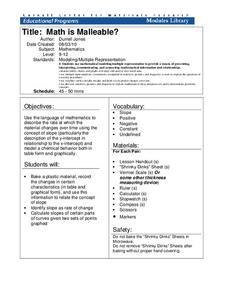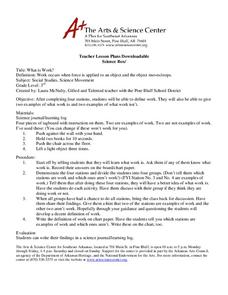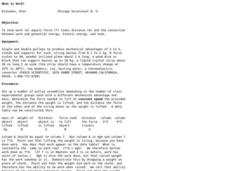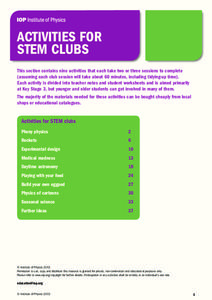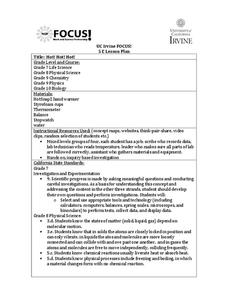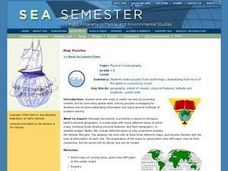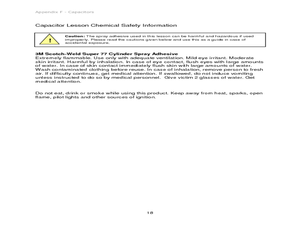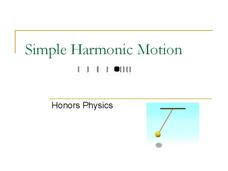Cornell University
Math Is Malleable?
Learn about polymers while playing with shrinky dinks. Young scholars create a shrinky dink design, bake it, and then record the area, volume, and thickness over time. They model the data using a graph and highlight the key features of...
University of Minnesota
Manduca sexta Wax Model
Caterpillars' and moths' most obvious change is physical, but what happens to their nervous systems as they complete metamorphosis? Through a hands-on investigation, young scholars construct the nervous system of a caterpillar. They then...
Curated OER
What is Everything Made of?
Students observe a demonstration on how we see space between water molecules. For this experimental lesson students discover what elements make up the things around them and discuss what they learned.
Curated OER
What is an Insect?
Students examine insects and identify physical characteristics of insects. They perform observations of insects, then use a worksheet imbedded in this plan to answer questions about them.
Curated OER
What is Work?
Third graders investigate the concept of force and work. In this physics lesson, 3rd graders visit four stations which include pushing the wall with your hand, holding books for ten seconds, pushing a chair, and lifting a light object....
Curated OER
What is Work?
Students investigate the connection between work, potential energy, kinetic energy, and heat. In this physics lesson plan, students use pulleys to produce mechanical advantages and incline planes to demonstrate energy conversion.
Institute of Physics
Activities for STEM Clubs
Need some support or ideas of how to entertain middle schoolers or what clubs to bring into your school? Let this excellent 40-page resource guide with links and step-by-step directions on STEM activities guide your decision.
Curated OER
Science: Generating Electricity
Eighth graders examine the various methods of generating electricity and explain their commonalities. They determine what is the most common source of energy and what are the potential environmental health hazards due to electrical...
Curated OER
Physical Science: Magnets
Students investigate magnets and how they work. They read and discuss the book, What Makes a Magnet and record their observations as they complete activities. After exploring the magnet set, they record their predictions and results...
Curated OER
What Is In The Water?
Learners investigate the biotic and abiotic factors that are found in an aquatic ecosystem. The emphasis is upon the investigation of present an projections of future water quality. Then students visit a local body of water to gather...
Curated OER
Physical Science: Bubble Prints
Students participate in a lab experiment involving soap bubbles and making bubble prints. They blow bubbles into the soap and add paint to make bubble prints. With extra time, they can play with a variety of bubble toys to see what...
Curated OER
What is Physical Change?
In this physical change worksheet, students will brainstorm types of physical change and will write down the cause and effect of each example in this graphic organizer.
US Navy
The Science of Diving
Introduce gas laws using the popular topic of SCUBA diving. This activity makes a connection between the gas laws and the effect of pressure and temperature changes during diving. Young engineers complete introductory experiments to...
University of California
Hot! Hot! Hot!
Calories are not tiny creatures that sew your clothes tighter every night, but what are they? A science lesson, presented at multiple levels, has learners experiment with heat, heat transfer, and graph the function over time....
Curated OER
Plate Tectonics Day 4 Earth's Interior Structure and Convection Currents
Students introduced to the interior structure of the Earth. They explore how the Earth's interior is broken down according to both it's physical properties and it's chemical composition. Students explore how convection currents within...
University of Colorado
Great Red Spot Pinwheel
The great red spot on Jupiter is 12,400 miles long and 7,500 miles wide. In this sixth part of a 22-part series, individuals model the rotation of the Great Red Spot on Jupiter. To round out the activity, they discuss their findings as a...
PHET
Mapping the Field of Multiple Dipole Magnets
So you built a magnetometer, now what? High school scientists use their magnetometer made in a previous lesson to map the union of magnetic fields of dipole magnets. They experiment with different alignments and draw conclusions about...
American Chemical Society
Combustion and Burning
On Earth, a candle flame points up, but on the International Space Station, it forms a sphere. Young scientists practice their skills by recording observations before, during, and after a candle burns. Chemical and physical...
Curated OER
Relative Age Dating
Modeling dough and paper cutouts in science class? Learn about how relative age dating concepts, like the Law of Superposition and cross-cutting relationships, can be used to describe the formation of sedimentary layers.
Curated OER
Map Puzzles
Young scholars make puzzles from world maps, dramatizing how much of the globe is covered by ocean.
Curated OER
Capacitors: What Are They?
Students discover how capacitors help store data. For this computer science lesson, students investigate how capacitors can store an electronic charge, eventually helping computers store data. Students create their own...
Science Friday
Capturing Carbon Dioxide
Why don't we just capture carbon dioxide in the air and store it somewhere else? A hands-on lesson allows scholars to explore a complex concept. First, they will create a carbonated beverage, and then they will determine...
Pingry School
Qualitative Analysis of Eleven Household Chemicals
Chemical and physical properties give compounds an identity. Learners use the identity of a compound to predict what it is. By performing different tests like solubility, flame, heat, and reactions, individuals attempt to identify an...
Curated OER
Simple Harmonic Motion
Back and forth, and back again. A presentation on harmonic motion would make a great backdrop for a directed instruction lesson in Honors Physics. It includes diagrams, formulas, graphs, and a few sample problems.
